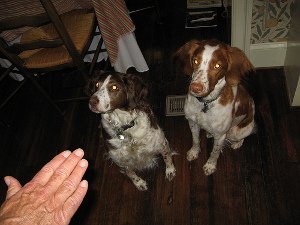|
Let’s start with this fact: dogs use body language to communicate. Sure, they can bark and growl. But much more of their communication is nonverbal. Bared teeth without gums showing, bared teeth with gums showing, a playful crouched posture, rolling over to show their belly, tail between their legs or tail wagging – body language is a major part of their communication.
So why are we so surprised that they don’t understand English?

We train our big dogs with words that make perfect sense to us but may not be easy to differentiate for them. Some dogs pick it up easily but others need a little more help. That’s where hand signals come in.
Hand signals are closer to their nonverbal body language and therefore easier to understand. Obedience classes often incorporate this into the training. Some big dogs pick up the hand signal for a command quicker than the word – and the hand signal then helps the dog learn the word. If your dog has had trouble learning verbal commands, adding a hand signal to the command may be just what you need to help the training along.
Hand signals come in handy when you can’t say the command to your big dog directly. If you’re on a phone call, for example, you can give your dog a command by hand signal without interrupting your conversation. Or if you’re at a distance you can still tell your big dog what you expect it to do.
Imagine this: Your big dog gets outsiide and runs across the street. You run out after her, only to see a neighbor coming down the street in his car. You don't want your dog running out in front of the car. You could yell a few commands, but as the car gets closer it will be harder for your dog to hear and more dangerous if she doesn't listen. Instead of yelling, you get your dog's attention and give your dog the hand signals for sit and stay. She does them. She sits and stays until you walk across the street, get hold of her collar, and carefully walk her back to your house once it's safe.
Useful, right?
A word of caution: make sure that the hand signals you assign to commands are different enough from each other that your dog can easily tell which signal you are using. Some signals I use:
-
Sit: index finger raised, other fingers folded (like making the sign for the number 1)
-
Lie down: Same as sit but with motion towards the ground
-
Stay: Flat hand, with fingers pointed up and palm towards the dog
-
Come: two hands flat patting my legs twice
Each of these are distinct, either by hand position or motion, and can be understood at a distance. They’ve come in handy more times than I can count and made initial training so much easier than it has been with previous dogs when I didn’t use hand signals. For your own dog, feel free to use these, adapt them, or create ones that feel natural to you. They need to be hand signals that will easily become second nature to you but also be easily differentiated by your dog. Simpler is better.
Did this post teach you something you can use with your big dog? Get more practical tips when you sign up for our e-newsletter. Just enter your name and email in the green box to the right.
If you liked this, you may also like:
The Best Training Tip I Ever Heard
Dog Body Language Decoded
Therapy Dog Training - Getting Started
Photo credit:
|